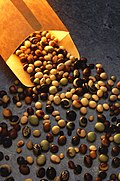Soybean
Soybean (Glycine max) is a species of legume native to East Asia, widely grown for its edible bean which has numerous uses. Soybeans are an important source of protein and oil for many food products, as well as feed for livestock. They are also used for a variety of non-food purposes such as biodiesel fuel, plastics, and textiles.
History[edit]
- Soybeans have been cultivated in East Asia for thousands of years, with records dating back to the Zhou dynasty in China (1046-256 BCE). The crop was introduced to other parts of the world in the 18th and 19th centuries, and today soybeans are grown in many regions including North and South America, Europe, Africa, and Australia.
Cultivation[edit]
- Soybeans are typically grown in warm climates with moderate rainfall, and are planted in the spring and harvested in the fall. The crop is typically rotated with other crops to maintain soil health, and may be treated with pesticides to control pests and diseases.
Uses[edit]
- Soybeans have a wide range of uses, both as a food and non-food product. In the food industry, soybeans are used to produce a variety of products including tofu, soy milk, soy sauce, and vegetable oil. They are also used as a source of protein in animal feed.
- Outside of the food industry, soybeans are used for a variety of non-food purposes. Soybean oil is used as a base for biodiesel fuel, and soybeans are also used in the production of plastics, textiles, and other industrial products.
Health benefits[edit]
- Soybeans are a good source of protein and contain a variety of vitamins and minerals including iron, calcium, and magnesium. They are also rich in antioxidants and phytochemicals, which may have health benefits such as reducing the risk of heart disease and certain types of cancer.
- However, soybeans contain compounds called isoflavones, which have been associated with hormone disruption and other health concerns. While research is ongoing, some experts recommend limiting soy consumption for certain individuals such as pregnant women and those with thyroid problems.
See also[edit]
External links[edit]
| This article is a stub. You can help WikiMD by registering to expand it. |
-
Soybean
-
Soybean
-
Soybean
-
Soybean
-
Soybean
-
Soybean
-
Soybean
-
Soybean
-
Soybean
-
Soybean
-
Soybean
-
Soybean
Ad. Transform your life with W8MD's Budget GLP-1 injections from $75


W8MD offers a medical weight loss program to lose weight in Philadelphia. Our physician-supervised medical weight loss provides:
- Weight loss injections in NYC (generic and brand names):
- Zepbound / Mounjaro, Wegovy / Ozempic, Saxenda
- Most insurances accepted or discounted self-pay rates. We will obtain insurance prior authorizations if needed.
- Generic GLP1 weight loss injections from $75 for the starting dose.
- Also offer prescription weight loss medications including Phentermine, Qsymia, Diethylpropion, Contrave etc.
NYC weight loss doctor appointmentsNYC weight loss doctor appointments
Start your NYC weight loss journey today at our NYC medical weight loss and Philadelphia medical weight loss clinics.
- Call 718-946-5500 to lose weight in NYC or for medical weight loss in Philadelphia 215-676-2334.
- Tags:NYC medical weight loss, Philadelphia lose weight Zepbound NYC, Budget GLP1 weight loss injections, Wegovy Philadelphia, Wegovy NYC, Philadelphia medical weight loss, Brookly weight loss and Wegovy NYC
|
WikiMD's Wellness Encyclopedia |
| Let Food Be Thy Medicine Medicine Thy Food - Hippocrates |
Medical Disclaimer: WikiMD is not a substitute for professional medical advice. The information on WikiMD is provided as an information resource only, may be incorrect, outdated or misleading, and is not to be used or relied on for any diagnostic or treatment purposes. Please consult your health care provider before making any healthcare decisions or for guidance about a specific medical condition. WikiMD expressly disclaims responsibility, and shall have no liability, for any damages, loss, injury, or liability whatsoever suffered as a result of your reliance on the information contained in this site. By visiting this site you agree to the foregoing terms and conditions, which may from time to time be changed or supplemented by WikiMD. If you do not agree to the foregoing terms and conditions, you should not enter or use this site. See full disclaimer.
Credits:Most images are courtesy of Wikimedia commons, and templates, categories Wikipedia, licensed under CC BY SA or similar.
Translate this page: - East Asian
中文,
日本,
한국어,
South Asian
हिन्दी,
தமிழ்,
తెలుగు,
Urdu,
ಕನ್ನಡ,
Southeast Asian
Indonesian,
Vietnamese,
Thai,
မြန်မာဘာသာ,
বাংলা
European
español,
Deutsch,
français,
Greek,
português do Brasil,
polski,
română,
русский,
Nederlands,
norsk,
svenska,
suomi,
Italian
Middle Eastern & African
عربى,
Turkish,
Persian,
Hebrew,
Afrikaans,
isiZulu,
Kiswahili,
Other
Bulgarian,
Hungarian,
Czech,
Swedish,
മലയാളം,
मराठी,
ਪੰਜਾਬੀ,
ગુજરાતી,
Portuguese,
Ukrainian











